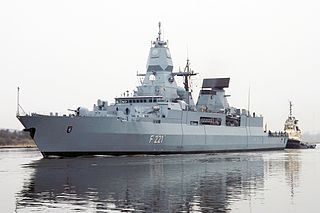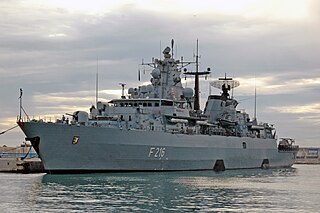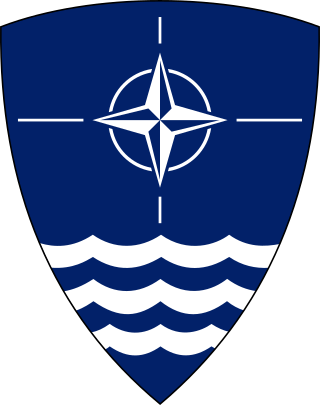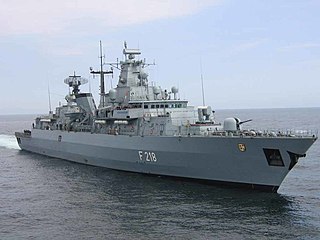
The German Navy is part of the unified Bundeswehr, the German Armed Forces. The German Navy was originally known as the Bundesmarine from 1956 to 1995, when Deutsche Marine became the official name with respect to the 1990 incorporation of the East German Volksmarine. It is deeply integrated into the NATO alliance. Its primary mission is protection of Germany's territorial waters and maritime infrastructure as well as sea lines of communication. Apart from this, the German Navy participates in peacekeeping operations, and renders humanitarian assistance and disaster relief. It also participates in anti-piracy operations.

The F124 Sachsen class is the German Navy's latest class of air-defense frigates. The design of the hull is based on that of the F123 Brandenburg class but with enhanced stealth features designed to deceive an opponent's radar and acoustic sensors. The class incorporates an advanced multifunction radar APAR and a SMART-L long-range radar which is purported to be capable of detecting stealth aircraft and stealth missiles.

The F123 Brandenburg class is a class of German frigate. They were ordered by the German Navy in June 1989 and completed and commissioned between 1994 and 1996, replacing the Hamburg-class destroyers. The ships primarily carry out anti-submarine warfare (ASW), but they also contribute to local anti-aircraft defenses, the tactical command of squadrons, and surface-to-surface warfare operations. Together with the F124 Sachsen-class frigates, they are the mainstay of the German surface fleet.

The F125 Baden-Württemberg-class frigates are a series of frigates of the German Navy, which were designed and constructed by ARGE F125, a joint-venture of Thyssen-Krupp and Lürssen. The Baden-Württemberg class is the heaviest displacement of any class of frigates worldwide. They replaced the F122 Bremen class. They are primarily designed for no and low intensity maritime stabilization operations, where they are supposed to provide sea-to-land tactical fire support, asymmetric threat control at sea and support of special forces.

SMS Württemberg was one of four Sachsen-class armored frigates of the German Kaiserliche Marine. Her sister ships were Sachsen, Bayern, and Baden. Württemberg was built in the AG Vulcan shipyard in Stettin from 1876 to 1881. The ship was commissioned into the Imperial Navy in August 1881. She was armed with a main battery of six 26 cm (10.2 in) guns in two open barbettes.

Allied Forces Baltic Approaches (BALTAP) was a Principal Subordinate Command (PSC) of the NATO Military Command Structure, with responsibility for the Baltic Sea area. It was in existence from 1962 to 2002 and consisted of the Danish Armed Forces, units of the West German Bundeswehr and allied wartime reinforcements.

Sachsen is a Sachsen-class frigate of the German Navy, the lead ship of her class.

Hamburg is a Sachsen-class frigate of the German Navy.

Hessen is a Sachsen-class frigate of the German Navy.

Brandenburg is a Brandenburg-class frigate of the German Navy, and the lead ship of her class.

Bayern is a Brandenburg-class frigate of the German Navy.

Mecklenburg-Vorpommern (F218) is a Brandenburg-class frigate of the German Navy.

Bremen was a Bremen-class frigate of the German Navy. She was the lead ship of the class, and the second surface warship to serve with one of the navies of Germany to be named after the city of Bremen, in the state of Bremen. Her predecessor was the cruiser SMS Bremen of the Imperial German Navy, one of the Bremen class cruiser.

Emden was a Bremen-class frigate of the German Navy. She was the fourth ship of the class, and the fifth ship to serve with one of the navies of Germany to be named after the city of Emden, in Lower Saxony. Her predecessor was the frigate Emden of the Bundesmarine, one of the Köln class.

Köln was a Bremen-class frigate of the German Navy. She was the fifth ship of the class, and the fifth ship to serve with one of the navies of Germany to be named after the city of Cologne, in North Rhine-Westphalia. Her predecessor was the frigate Köln of the Bundesmarine, lead ship of the Köln class.

Karlsruhe was a Bremen-class frigate of the German Navy. She was the sixth ship of the class to enter service, and the fifth ship to serve with one of the navies of Germany to be named after the city of Karlsruhe, in Baden-Württemberg. She is currently laid up, pending disposal as a trials and target ship.

Augsburg is a Bremen-class frigate of the German Navy. The vessel was laid down in April 1987 by Bremer Vulkan, in Bremen, Germany and launched on 17 September 1987. The vessel was commissioned on 3 October 1989. The ship has been deployed as part of Operation Enduring Freedom – Horn of Africa and Operation Atalanta in the Middle East and Indian Ocean and has seen service in the Mediterranean Sea. The vessel is currently based at Wilhelmshaven, Germany.

Lübeck was a Bremen-class frigate of the German Navy.


















